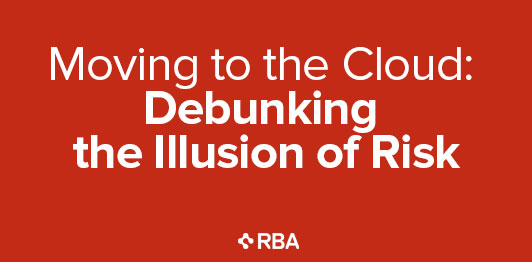Even with all of the information available today about the “Cloud,” many companies still fear migrating their mission-critical applications to the Cloud, or deploying new ones to the Cloud. In this article, we challenge three common areas of concern.
Physical Access is Critical
In traditional “on-premises” environments, software generally runs on a single device, or a small number of physical devices. If application performance begins to degrade, someone can simply reboot the machine in the server room and that might do the trick. If your office temporarily loses Internet connectivity, you can still access the application or important data locally. There’s a certain level of comfort in these scenarios.

In a Cloud environment, applications are broken down into workloads that run on multiple devices in one or more locations around the world. The concept of “where” the software is loses meaning. Some people find that unsettling.
In reality, the distribution of components into the Cloud affords multiple advantages:
-Cloud infrastructure is typically far better protected than any on-premises (and even some hosted) environments from theft, accidents, malicious acts, or damage due to weather events, electrical surges, or other causes.
-Leading Cloud-based infrastructure platforms, such as Microsoft Azure, provide robust toolsets for managing applications in the Cloud—which are often superior to management tools for local or hosted applications. They’re designed to be accessed remotely, which gives IT professionals more flexibility.
-The distributed nature of Cloud architecture means that if any one piece fails, the entire application is not necessarily rendered inoperable. Cloud platforms are designed for rapid failover, if necessary.
My Data is Less Secure in the Cloud
Things that look secure feel secure. If you can’t see it, it’s easy to question whether it’s secure. Cloud platforms exist on the Internet and are designed to connect to multiple other systems and to end-users—this could be potentially millions of people. Thus, it might seem that Cloud-based applications are more accessible to hackers than, say, an on-premises database server that can be instantly disconnected from the Internet by unplugging an Ethernet cable.
Here’s the truth: Any system that interacts with the outside world has some degree of vulnerability. Whether it is in the cloud or sitting in a closet disconnected from the network, a system without the appropriate security and governance models defined and implemented can be compromised. That’s all the more reason to trust protecting your infrastructure to a leading company that has the resources and expertise to minimize the risk. Microsoft, for example, has invested billions of dollars in developing its Azure platform and a significant portion of that investment has been made in security and compliance. There’s little chance that any single company could protect their infrastructure comparably well.
Pricing for the Cloud is Unpredictable
Costing on-premise or hosted application environments is easy: you know the price of the hardware on which it runs, as well as the costs of licensing additional software components, hosting fees, and other line items. You can add it all up and state with some confidence how much it will cost your company this year.
One downside, however, is that you’ll probably over-buy, for two reasons:
-You’ll probably anticipate growth and will buy hardware that meets the performance expectations you anticipate you will need to deliver at some point in the future. You might also purchase additional hardware for backup or testing purposes.
-You’ll inevitably have to pay for hardware that does more than you need it to, because you’ll be running applications on a small number of machines and each machine needs to do everything your application does, not just a portion of it.
Pricing for the Cloud is more complex and less predictable, but also far more flexible, cost-efficient, and responsive to end-customer usage if your application is architected on a leading platform. In a Platform-as-a-Service (PaaS) model, there are no up-front costs. You’re not buying hardware such as servers; you’re buying fractions of processing power or capacity, each optimized to handle specific workloads. And you’ll never buy more than you need. Rather, you can add capacity immediately when—and if—needed. With a platform like Microsoft Azure, you pay only for what you use. If demand on your application spikes, you pay more. If it falls, you pay less.

Granted, re-architecting an existing application for a Cloud platform can represent a significant investment. But it’s often money well spent; once that investment is made, the application becomes infinitely scalable in a highly cost-efficient manner.
Moving applications to a Cloud platform—or building applications from scratch on one—requires careful planning and expert guidance. But it shouldn’t be scary. As millions of businesses have discovered, the benefits of the Cloud far outweigh any perceived risks.
Want to learn more about the competitive advantages of the Cloud and how to determine the right Cloud platform for your organization? Download RBA’s white paper, Gaining a Competitive Advantage with Platform-as-a-Service (PaaS).


